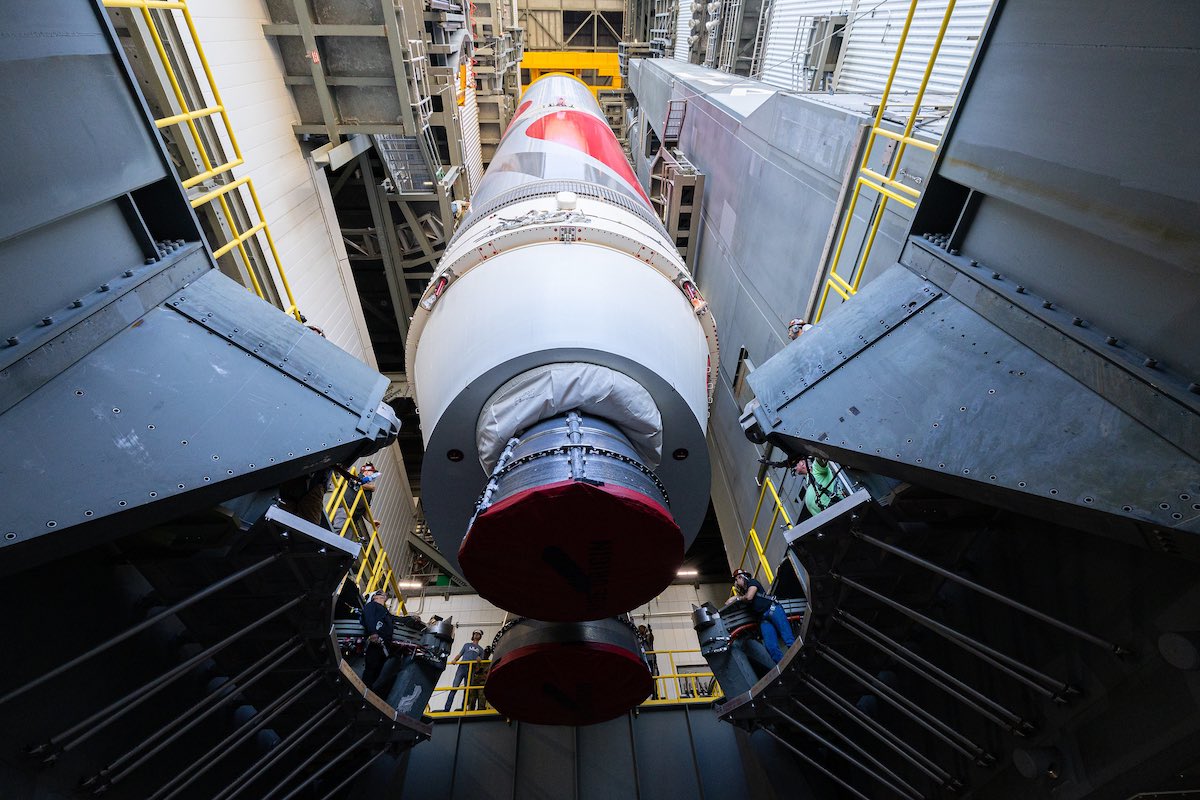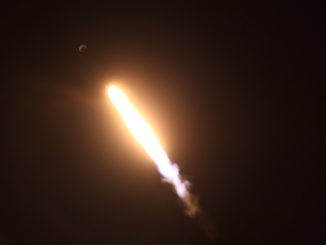
United Launch Alliance called off a test-firing of the company’s first flight-rated Vulcan Centaur rocket at Cape Canaveral Thursday to troubleshoot a problem with the booster’s engine ignition system.
Ground crews planned to ignite the Vulcan rocket’s two Blue Origin-built BE-4 engines on a launch pad at Cape Canaveral Space Force Station Thursday evening, but ULA officials postponed the test-firing and roll the rocket back to its hangar for repairs.
“During the countdown, the team observed a delayed response from the booster engine ignition system that needs further review prior to proceeding with the flight readiness firing,” ULA said in a statement Thursday. “We will be rolling the rocket back to the Vertical Integration Facility to gain access to the booster ignition system.”
ULA rolled the rocket on its mobile launch platform back to the Vertical Integration Facility Friday. The company has not set a new target date for the six-second test-firing of the first stage’s two BE-4 engines, a prerequisite for the inaugural launch of the Vulcan Centaur rocket designed to replace ULA’s Atlas and Delta rocket families.
“The team will continue to review data and determine when Vulcan can roll back to the pad to conduct the flight readiness firing,” ULA said.
The flight readiness firing will be the culmination of a series of tests and countdown rehearsals at Cape Canaveral to prepare for the first Vulcan test flight. Most recently, ULA’s launch team loaded methane, liquid hydrogen, and liquid oxygen propellants into the Vulcan booster and its Centaur upper stage during a May 12 tanking test. The countdown for the flight readiness firing will follow a similar timeline as the May 12 tanking test, including propellant loading operations, built-in holds, and readiness polls of the launch team.
ULA moved the Vulcan Centaur rocket back to the Vertical Integration Facility after the May 12 tanking test to make “adjustments” to the vehicle. The changes included adjusting a setting with ground hydraulic pressure, changing the topping rate for liquid oxygen, and changing the flow of purge and chill gas to the BE-4 engine igniters, according to Tory Bruno, ULA’s chief executive officer.
In parallel with the preparations for the flight readiness firing, ULA engineers continue investigating a hydrogen explosion in March that cut short a structural test of the Vulcan rocket’s Centaur upper stage at NASA’s Marshall Space Flight Center in Huntsville, Alabama. The blast damaged the test stand and a Centaur upper stage test article. The Vulcan rocket will use a larger, upgraded model of the Centaur upper stage currently flying on ULA’s Atlas 5 rocket.
If engineers determine they don’t need to make any changes to the Centaur upper stage on the first Vulcan rocket, the test flight could take off this summer. Bruno said the mission could delay until later this year if corrective actions are required on the Centaur.
ULA is a 50-50 joint venture between Lockheed Martin and Boeing, which merged their Atlas and Delta rocket programs in 2006. The Vulcan rocket will fly in several configurations, with varying numbers of strap-on solid rocket boosters and different payload fairing sizes available on each flight, depending on mission requirements.
The Vulcan rocket for the program’s first test flight sports a colorful paint job with a bright red flame emblazoned on the side of the 17.7-foot-side (5.4-meter) first stage. For the tanking tests and the Flight Readiness Firing, the Vulcan rocket is not fitted with any solid rocket boosters or a payload fairing. In that configuration, the vehicle stands about 166 feet (50.7 meters) tall.
Once the test-firing is complete, ULA will install two of the Northrop Grumman-built solid-fueled boosters and the payload shroud supplied by Beyond Gravity, formerly known as Ruag Space.
The Vulcan rocket’s inaugural flight will be the first first launch to use new methane-fueled BE-4 engines from Blue Origin, founded by billionaire Jeff Bezos. At full throttle, each BE-4 engine can generate about 550,000 pounds of thrust. Two of them will power each Vulcan core stage, with zero, two, four, or six solid rocket boosters to add thrust in the first couple of minutes of flight.
The Vulcan rocket’s Centaur upper stage, called the Centaur 5, is an upgrade to the upper stages currently flying on ULA’s Atlas 5 rocket. The Centaur 5 has a wider diameter to accommodate larger cryogenic hydrogen and oxygen propellant tanks, along with two Aerojet Rocketdyne RL10 engines. The Centaur flying on the Atlas 5 rocket typically flies with a single engine.
Once all of the Vulcan rocket configurations are operational, the new rocket will fully replace and grow the lift capability currently offered by all of ULA’s rockets. The largest Vulcan rocket variant, with a single core stage, will have more payload lift capability than ULA’s Delta 4-Heavy, which has three liquid-fueled first stage boosters connected together.
Eventually, ULA plans to recover the reuse BE-4 engines from Vulcan launches, but not the entire first stage.
ULA unveiled the Vulcan rocket in 2015, then targeting a first launch of the new vehicle in 2019. The company selected Blue Origin’s BE-4 engine for the first stage propulsion system in 2018. At that time, ULA aimed to launch the first Vulcan test flight in 2020.
But delays, primarily caused by issues discovered in BE-4 engine production and testing, forced the first Vulcan test flight to slip several years. Bruno said earlier this month that Blue Origin and ULA completed final qualification testing of the BE-4 engine ahead of the first Vulcan launch, clearing a hurdle that was still threatening to delay Vulcan’s debut earlier this year.
On its first flight, the Vulcan rocket will launch a commercial moon lander developed by Astrobotic, which will attempt to deliver a batch of NASA experiments and tech demo payloads to the lunar surface. The Astrobotic lander, named Peregrine, is part of NASA’s Commercial Lunar Payload Services Program, which buys rides to the moon for agency payloads on commercially-owned spacecraft.
Two prototype satellites for Amazon’s Kuiper broadband network will also be aboard the first Vulcan launch.
ULA’s Vulcan rocket has been selected by the U.S. Space Force to launch the majority of the military’s large national security satellites for the next five years. The military requires to “certification flights” of the Vulcan rocket before it is approved for national security launch missions.
Email the author.
Follow Stephen Clark on Twitter: @StephenClark1.



